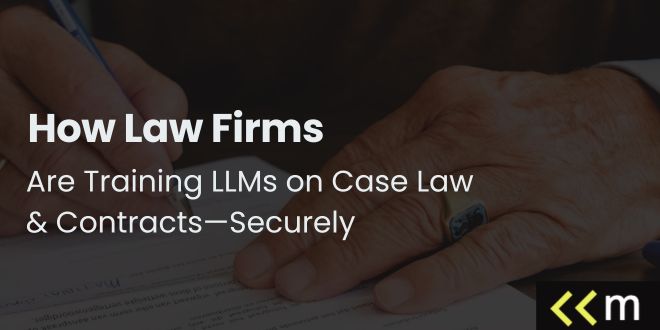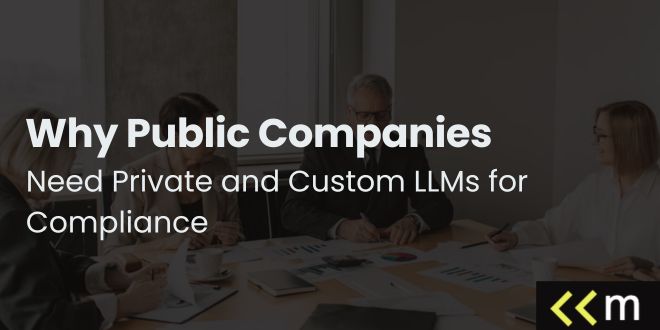Private LLMs for Law Firms: How Law Firms Are Training LLMs on Case Law & Contracts—Securely

Large Language Model technology has broken out of research labs and consumer chat assistants and is now knocking on the door of the legal profession. Forward-thinking firms no longer see generative AI as a novelty; they view it as a force multiplier—one that can sift through thousands of pages of precedent, summarize complex clauses, and even suggest drafting tweaks in seconds. Yet those same firms live and die by confidentiality.
The journey to train an in-house model on sensitive case law, client memos, and negotiated contracts therefore begins and ends with an ironclad security strategy. Below is a practical look at how elite firms are doing exactly that.
Why Law Firms Are Betting on Their Own LLMs
Law firms are seeing vast opportunities in using LLMs to enhance workforce efficiency, but private LLM software and services are becoming more of the norm for law firms seeking control and compliance.
From Billable Hours to AI-Powered Minutes
Partners have long relied on armies of associates to comb through discovery, assemble deal bibles, and trace precedent. A finely tuned LLM collapses that workflow from hours to minutes, freeing up lawyers to focus on analysis and strategy rather than brute-force document review. Faster turnaround also strengthens client relationships; nobody complains when a 48-hour research request comes back in three.
A private LLM is a model you host and control. It can be:
- On-premises: running on servers/GPUs you own. There are inherent difficulties in on-prem LLMs.
- Private cloud: isolated VPC with strict network and data policies.
- Hybrid: local data stores + cloud compute with encryption and access controls.
Private LLMs can power familiar legal workflows—intake triage, clause comparison, research summaries, deposition prep, and draft generation—without sending sensitive data to a public, shared model.
What Makes Legal Data Unique—And Tricky for AI
- Attorney-client privilege attaches to nearly every internal memo.
- Contracts can contain trade secrets for multiple parties, not just the firm’s client.
- Case law is public, but the way a firm annotates or tags those opinions is often proprietary.
- Jurisdictional differences (EU GDPR, U.S. state privacy laws, China’s PIPL, etc.) add a layer of cross-border complexity.
These elements collectively demand safeguards that go beyond standard enterprise IT policies.
Building and Training the Model Without Leaking the Brief
Lock Down the Dataset First
Security doesn’t start at deployment; it starts when paralegals and data engineers assemble the corpus. Best-in-class practices include:
- Granular access controls: Only a need-to-know subset of staff can touch raw documents.
- Automated redaction: Sensitive names, addresses, Social Security numbers, and bank details are masked before training.
- Encryption at rest and in transit: Files sit on encrypted disks and move through TLS-protected tunnels.
- Immutable audit logs: Every pull request, data transformation, or deletion is time-stamped and signed.
Secure Fine-Tuning Techniques
Once the data is sanitized, firms employ multiple layers of model-level security:
- On-premise GPU clusters or private virtual clouds, isolated from public endpoints.
- Differential privacy noise injection, blurring out any possibility the model memorizes a unique clause.
- Retrieval-augmented generation (RAG) so the core model remains generic while sensitive knowledge lives in a separately secured vector store.
- Parameter-efficient fine-tuning (LoRA, adapters) that lets the firm keep the base model intact and swap out confidential weights if a breach occurs.
Private vs. Public LLMs for Law Firms: A Breakdown
Real-World Safeguards Inside the Firm
Technological controls are necessary but not sufficient. Human processes still matter:
- Role-based policy training for attorneys and support staff on how to prompt the model without pasting privileged text unnecessarily.
- Mandatory human-in-the-loop review for every client-facing output—no exceptions, even for seemingly trivial legal summaries, ensuring attorney-client privilege is maintained.
- Kill-switch protocols, allowing IT to revoke model access within minutes if suspicious activity is detected.
The Compliance Tightrope: Ethics, Regulation, and Reputation
Regulatory bodies from the American Bar Association to the UK’s SRA all emphasize competence and confidentiality. A firm deploying an LLM must show it understands both. Common steps include:
- Mapping model life-cycle controls to ISO/IEC 27001, SOC 2, and NIST 800-53 frameworks.
- Documenting fairness evaluations to avoid inadvertent bias (e.g., discriminatory sentencing predictions).
- Aligning prompt-and-response logging with e-discovery obligations; what the model sees today could become tomorrow’s evidence.
Human-in-the-Loop as a Safety Net
Even the best guardrails can’t anticipate every edge case. Senior associates and partners therefore act as the final certifiers, applying professional judgment that no machine can replicate. Some firms even integrate model output into their existing knowledge-management system, automatically flagging discrepancies between AI-generated text and established house style or precedent.
Looking Ahead: Federated and Synthetic Data
The next frontier is training across multiple offices or even consortiums of smaller firms without centralizing raw documents. Federated learning sends model updates—not data—over secure channels, preserving local confidentiality. Where data is too scarce or sensitive, synthetic contracts generated from statistical patterns provide additional training material without exposing real client secrets.
The Necessity of LLMs for Law Firms
Training an LLM on case law and contracts is no longer science fiction for law firms—it’s a competitive necessity.
The firms that succeed will be those that blend cutting-edge AI engineering with the profession’s long-standing culture of confidentiality.
Secure data pipelines, private fine-tuning environments, rigorous human oversight, and proactive regulatory alignment turn potential pitfalls into guardrails. Do it right, and the result is a trusted digital colleague that boosts productivity, sharpens insights, and keeps every privileged detail exactly where it belongs: inside the firm’s virtual four walls.
Samuel Edwards is an accomplished marketing leader serving as Chief Marketing Officer at LLM.co. With over nine years of experience as a digital marketing strategist and CMO, he brings deep expertise in organic and paid search marketing, data analytics, brand strategy, and performance-driven campaigns. At LLM.co, Samuel oversees all facets of marketing—including brand strategy, demand generation, digital advertising, SEO, content, and public relations. He builds and leads cross-functional teams to align product positioning with market demand, ensuring clear messaging and growth within AI-driven language model solutions. His approach combines technical rigor with creative storytelling to cultivate brand trust and accelerate pipeline velocity.







